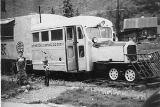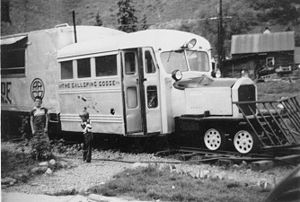
Galloping Goose
Encyclopedia

Railcar
A railcar, in British English and Australian English, is a self-propelled railway vehicle designed to transport passengers. The term "railcar" is usually used in reference to a train consisting of a single coach , with a driver's cab at one or both ends. Some railways, e.g., the Great Western...
s, (officially designated as "motors" by the railroad) built in the 1930s by the Rio Grande Southern Railroad
Rio Grande Southern Railroad
The Rio Grande Southern Railroad was a narrow gauge railroad which ran from Durango to Ridgway in the western part of the US state of Colorado...
(RGS) and operated until the end of service on the line in the early 1950s.
Originally running steam locomotives on narrow gauge railways, the perpetually-struggling RGS developed the first of the "geese" as a way to stave off bankruptcy and keep its contract to run mail to towns in the Rocky Mountains
Rocky Mountains
The Rocky Mountains are a major mountain range in western North America. The Rocky Mountains stretch more than from the northernmost part of British Columbia, in western Canada, to New Mexico, in the southwestern United States...
in Colorado
Colorado
Colorado is a U.S. state that encompasses much of the Rocky Mountains as well as the northeastern portion of the Colorado Plateau and the western edge of the Great Plains...
. There was not enough passenger or cargo income to justify continuing the expensive steam train service at then-current levels, but it was believed that a downsized railway would return to profitability. The steam trains would transport heavy cargo and peak passenger loads but motors would handle the lighter loads.
Motors were not only less expensive to operate, but were also significantly lighter, thus reducing impact on the rails and roadbeds. This cost saving meant that the first Goose was paid off and making a profit within three weeks of going into service. RGS built more Geese, and operated them until the company abandoned their right-of-way in 1952.
History
The RGS built its first motor in 1913, as a track maintenance crew vehicle. This was wrecked in 1925, but inspired the idea of using motors for scheduled service.All of the "geese" were built in the railroad's shops at Ridgway, Colorado
Ridgway, Colorado
The Town of Ridgway, coined Gateway to the San Juans, is a Home Rule Municipality in Ouray County, in the southwestern portion of the U.S. State of Colorado. The town is a former railroad stop on the Uncompaghre River in the northern San Juan Mountains...
. The first was built in 1931 from the body of a Buick
Buick
Buick is a premium brand of General Motors . Buick models are sold in the United States, Canada, Mexico, China, Taiwan, and Israel, with China being its largest market. Buick holds the distinction as the oldest active American make...
"Master Six" four-door sedan. It was more conventional in its construction than the later geese, though it had a two-axle truck
Bogie
A bogie is a wheeled wagon or trolley. In mechanics terms, a bogie is a chassis or framework carrying wheels, attached to a vehicle. It can be fixed in place, as on a cargo truck, mounted on a swivel, as on a railway carriage/car or locomotive, or sprung as in the suspension of a caterpillar...
in place of the front axle. Part of the rear of the car was replaced by a truck stake-bed for carrying freight and mail; this was later enclosed and partially fitted with seating. It was used for two years to carry passengers, US Mail, and light freight before being scrapped. A second "goose" was built in the same year from another Buick, but later versions used Pierce-Arrow
Pierce-Arrow
Pierce-Arrow was an American automobile manufacturer based in Buffalo, New York, which was active from 1901-1938. Although best known for its expensive luxury cars, Pierce-Arrow also manufactured commercial trucks, fire trucks, camp trailers, motorcycles, and bicycles.-Early history:The forerunner...
bodies except for #6, which was constructed partly out of parts taken from the scrapped #1.
Numbers 2 and 6 were constructed with two trucks, with the rear truck powered on both axles. #2 had an enclosed freight compartment (like a very short boxcar
Boxcar
A boxcar is a railroad car that is enclosed and generally used to carry general freight. The boxcar, while not the simplest freight car design, is probably the most versatile, since it can carry most loads...
), while #6 had an open bed similar to #1 (but larger). It was used only for work train service. The other four had three trucks and were articulated in the same manner as a tractor-trailer truck. In these, the second truck was powered, and the freight compartment was essentially a conventional boxcar.
Initially the "geese" were painted in black and dark green. In 1935 they were all painted in a silver scheme which they retain to this day, though the style of lettering and heralds changed over the years. In 1945 #3, #4, and #5 were rebuilt with Wayne bus bodies (at least the front half) replacing the old Pierce-Arrow bodies. This provided more passenger seating and comfort. A year later they also received new war surplus GMC engines.
In 1950, when the railroad finally lost its mail contract (in favor of highway mail carriers), #3, #4, #5, and #7 were converted for tourist operations, and the "Galloping Goose" name was officially recognized by the railroad. Large windows were cut in the sides of the freight compartments, and seating was added. A figure of a running goose and the words "Galloping Goose" were added to the carbody doors. This service lasted only two years, and the last work of the "geese" on their home line was to take up the rails.
It is unclear exactly where the name "Galloping Goose" comes from. It is mostly commonly suggested that it referred to the way the carbody and the freight compartment tended to rock back and forth on the line's sometimes precarious track. It is also suggested, though, that the name arose because the "geese" were equipped with air horns rather than the whistles of the steam locomotives. The name was used informally for years before the tourist operations, though the railroad officially referred to the units as "motors".
A similar unit was built for the San Cristobal Railroad and was rebuilt by the RGS in 1934-35. When the San Christobal folded in 1939, this unit was returned to the RGS and dismantled, with some parts going to rebuild and maintain the #2 Goose.
The Galloping Goose Regional Trail on Vancouver Island
Vancouver Island
Vancouver Island is a large island in British Columbia, Canada. It is one of several North American locations named after George Vancouver, the British Royal Navy officer who explored the Pacific Northwest coast of North America between 1791 and 1794...
was named after a similar unit that ran on the Vancouver Island section of the Canadian National Railway
Canadian National Railway
The Canadian National Railway Company is a Canadian Class I railway headquartered in Montreal, Quebec. CN's slogan is "North America's Railroad"....
from 1922 to 1931.
Galloping Goose #5 (along with many local landmarks) was popularized in C. W. McCall's song, "Gallopin' Goose".
Surviving units

- Geese #2, #6, and #7 are preserved at the Colorado Railroad MuseumColorado Railroad MuseumThe Colorado Railroad Museum is a non-profit railroad museum The museum is located on at a point where Clear Creek flows between North and South Table Mountains in Golden, Colorado....
and are operational. - Goose #3 was sold to Knott's Berry FarmKnott's Berry FarmKnott's Berry Farm is a theme park in Buena Park, California, now owned by Cedar Fair Entertainment Company, and a line of jams, jellies, preserves, and other specialty food, now part of The J. M. Smucker Company based in Placentia, California....
and is operated regularly during off-season periods when park attendance is low. - Goose #4 was on static display in Telluride, ColoradoTelluride, ColoradoThe town of Telluride is the county seat and most populous town of San Miguel County in the southwestern portion of the U.S. state of Colorado. The town is a former silver mining camp on the San Miguel River in the western San Juan Mountains...
. It is currently in Ridgway, ColoradoRidgway, ColoradoThe Town of Ridgway, coined Gateway to the San Juans, is a Home Rule Municipality in Ouray County, in the southwestern portion of the U.S. State of Colorado. The town is a former railroad stop on the Uncompaghre River in the northern San Juan Mountains...
, undergoing cosmetic restoration, possibly to operation. - Goose #5 was bought by the city of Dolores, ColoradoDolores, ColoradoThe town of Dolores is a Statutory Town in Montezuma County, Colorado, United States. The population was 936 at the 2010 census. It is one of three incorporated municipalities in the county....
. After restoration in 1998 it is now operated from time to time on the Cumbres and ToltecCumbres and Toltec Scenic RailroadThe Cumbres & Toltec Scenic Railroad is a narrow gauge heritage railroad running between Chama, New Mexico and Antonito, Colorado. It runs over the Cumbres Pass, the highest point on a US passenger railway....
and Durango and SilvertonDurango and Silverton Narrow Gauge RailroadThe Durango and Silverton Narrow Gauge Railroad is a narrow gauge heritage railroad that operates of track between Durango and Silverton, in the US state of Colorado...
tourist railroads, as well as at the Colorado Railroad MuseumColorado Railroad MuseumThe Colorado Railroad Museum is a non-profit railroad museum The museum is located on at a point where Clear Creek flows between North and South Table Mountains in Golden, Colorado....
.

